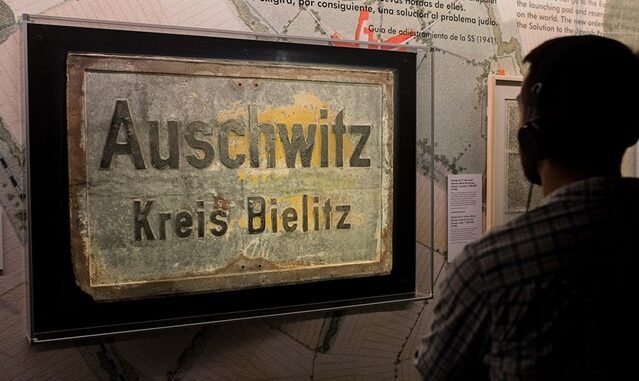

“It happened once, it could happen again.” The Holocaust, which murdered so many, was “not so long ago and not so far away.” In fact, it is a fear that continually rumbles through the Jewish community as antisemitism rises higher now.

Happening now and for the next 10 months the Regan library in Simi Valley has an exhibit on Auschwitz, the death Camp – one of the main killing centers of the Nazi regime.
Through the exhibit, you get a sense of what life was like before the Nazi occupation and then after.

Cattle car that brought Jews to Auschwitz – photo by Henry Tarlow
As you walk up to the library, you are first greeted by the brown cattle car. This small wooden railway cab held 100 or so humans who were given no food or water, and had no place to sit or even relieve themselves as they traveled several days from the Nazi-occupied areas where they were taken to these labor and death camps. There was no window, very little circulating air and many fainted or died on the way.
Entering the exhibit area, you’re given an audio deck and earphones. The exhibit is self-propelled and the audio tour is included in the price. At times, the narrative is hard to hear, but there are plenty of indications in the display that one can follow along even if the voice is difficult.

We start with the death camp fence and then a visual introduction to the small 900-year-old Polish town of Oswiecim, which at one time had a large population of successful Jewish merchants. Of course, none existed there after the war.

Photos showed many proud Jews displaying their medals of honor after having served in the German army during World War 1. They had fought valiantly and returned with honors. They believed that their patriotic participation and their assimilation would save them but Hitler told his followers that it was the Jews who caused Germany to lose the war.
Even educated people, searching for a way to explain their economic troubles, believe the lies and blamed the Jews and the Communists for the downswing in the economy. Because of these lies Jew hatred increased.
One display showed some of the 1930 Nuremberg laws which stated that Jews who were doctors, teachers, and government workers had to leave their jobs. Jewish children were not allowed to go to public schools. It became forbidden for non-Jews to shop in Jewish stores. People you thought were your friends began to turn away from you.

Another area showed the cartoons of what Jews were supposed to look like. It didn’t matter if you had even 1/16 of Jewish blood, you were considered a Jew and therefore tainted. If you looked Jewish with dark curly hair, a large nose, or large ears you could also be arrested, or even if you were a practicing Christian.
One short film talked about the antisemitic education for children that began with a book called “The Poisoned Mushroom,” which of Jews defiling the Aryan race.
Clips of the 1933 book burning horrified any reader. The brown shirts were shown destroying any books with Jewish subjects, by Jewish authors, or even by liberal writers such as Helen Keller.
In the beginning, if they could prove they have the ability to emigrate, some Jews were released. Maps of countries around the world that accepted refugee Jews were displayed…and they were astonishingly few. Therefore, most were incarcerated in Dachau, Buchenwald, and Sachsenhausen.
Chaim Weitzman (a former president of Israel) said, “There are two types of countries – the ones that want to expel the Jews and the others which refused to admit them.”

Finding a country to accept them was next to impossible. One ship coming to the shores of America was turned around and admittance was refused because the State Department did not want them.
Some who managed to escape tried to warn the Western allies of what was happening in Hitler’s Germany, but no one would listen. Or if they listened, they did not care. The world was silent. No one said a word.
The British who now had control of the Middle Eastern area called Palestine refused to admit the Jews who sought refuge because of the Arab riots.
Because Poland had the largest Jewish population it is where the killing centers were first established. When the town of Oswiecim was occupied in 1939, it was relabeled Auschwitz and here- just outside of town where an old Polish army barrack had been – the Germans built their death camp.
Maps of the old town and the early barracks showed the broken-down buildings where the Germans would house their prisoners.

Anti-Semites promulgated the theory that Jews were racially inferior and a threat to Western civilization. It was felt they could not be saved through conversion or assimilation.
A video of events from the violent Kristallnacht – the night of the broken glass – pogrom in November 1938, showed the synagogues burning and the shops being destroyed. It’s now that the Nazi officials conducted mass arrests of males who were arrested precisely because they were Jewish.
More displays depicted the occupied lands and the travels that many took as they traveled first to transit camps such as Westbrook in the Netherlands or Drancy in France. From there they were told they were going to labor camps but most of them were killing camps.
There were several main killing centers for the murder of the Jews. Besides Auschwitz, these included Mauthausen, Stutthof, Ravensbruck, and Lubin/Majdanek. Auschwitz was the main crematorium for the forced labor camps around.
Another map indicates that the Germans had over 44 camps in all.
In 1942, the Nazis opened Treblinka, Belzec, and Sobibor. Designed for efficient mass murder, they use Zyklon B gas in the crematoria. During the height of the deportations, an average of 6,000 Jews were gassed each day.
As you walk through you will see authentic possessions left by the victims. Masses of shoes, tons of hair, toys, and other artifacts fill one whole room. One shelf showed the bottles recovered from a Jewish factory that distilled spirits and another from a Jewish factory that had been a perfumery.

You’ll also see Nazi items such as SS boots, and gas masks. In all there are more than 700 objects of historical and humanitarian value that directly tell of the Holocaust horrors and enough to shock those viewing.
Once in the camps, we see remains of religious artifacts as many tried to keep up their traditions. Author Eli Wiesel traded 12 rations for tefillin (prayer boxes) which he shared with many of the other prisoners while another managed to sneak in a shofar (ram’s horn) to blow for the holiday. And secretly many Christians and Jews prayed together.

The exhibit goes on to explain a little about anti-Semitism in the past which has been going on since Roman times and before.
In 1551, King Ferdinand the First had issued a proclamation that Jews had to wear a yellow star. A short film shows how Himmler was given a copy of this declaration as a birthday present and the excitement he had that he was on the right track for insisting Jews be marked.

While Jews were the majority of those murdered at Auschwitz other prisoners included Roma, Poles, disabled German patients, homosexuals, Afro-German children from mixed marriages, and Soviet prisoners.
The exhibit is extremely educational and factual, especially for those who have no knowledge of the Holocaust or have no distant relatives who suffered during it. In fact, it’s a slap in the face for Holocaust deniers.
However, for a heart-tugging experience, you might consider visiting the Museum of Tolerance. (Here you actually step into the shoes of a death camp prisoner – but not everyone can tolerate this.)
Be prepared with good walking shoes because the exhibit takes a good two to three hours to explore. There are a few wheelchairs available for those that need them (but reserve this beforehand or bring your own), and a few benches along the way to rest, but no bathrooms in the exhibit itself.
This exhibition is recommended for ages 12+. Although the history of Auschwitz is challenging, they have developed this exhibition not only with profound respect for the victims but also for visitors. Care has been taken to ensure that there are no gratuitous depictions of violence. Every effort has been made to consider the emotional impact this story can have but this history is crucial to understand.
Costs are $29 for adults with discounts for students and seniors. Groups of more than 25 can get a discount as well. Reservations have filled up fast and the exhibit only goes until late August 2023. Tickets, which are timed so that all can enjoy the exhibit without rushing, are for the Auschwitz exhibit only and not for the main Regan Museum and Air Force One Pavilion. A separate fee must be paid for that and you would want to do it before you do the Auschwitz tour.
A small café is on the premises or you can bring a lunch and buy drinks.
Let’s pray it never happens again, but education is the best way to prevent it. So bring your children, grandchildren, friends, and neighbors. It’s a great start to learn what the Holocaust was about.




Be the first to comment